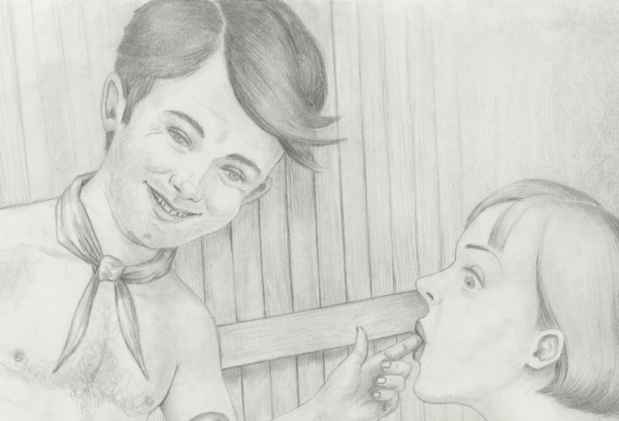Ion Birch “Holy Man”
Horton Gallery

This event has ended.
Pleasure, playfulness, power and profundity are all present in Holy Man, Ion Birch’s series of graphite drawings. But isolating these elements is simply naming the different ingredients in sex. While Birch’s bacchanalian graphite images raise compelling questions, his brilliance lies in never letting them distract from the sexual delight that his works depict and inspire. Indeed, the key to Birch’s art’s impact is that he doesn’t take sex too seriously; just seriously enough. As Woody Allen said, “I don’t know the question, but sex is definitely the answer.”
The sexual scenarios that Birch depicts range from a good night at a swingers’ party to impossible fantasy-scenes pulsating between ecstasy and fever-dream. Earlier, his imagery confronted a recognizably American brand of sexual repression. Although he was raised in international counter-culture communities in Trinidad and Tobago, many of Birch’s characters appeared to have just remembered their bodies under the Polo shirts and shorts they wore when mowing middle-class suburban lawns. Similarly, the characters in Birch’s images are not porn stars or dream girls. They are plucked from everyday life. And like happy hedonists in amateur porn forums, their palpable delight at exposing their desires and flaunting their sexualities is as touching as it is arousing. Carnal but cerebral, Birch’s art combines the gleeful humor of Gerard Damiano’s dirty movies with Henry Miller’s gritty social critique. Like the real-world swinger population, the majority demographics of Birch’s drawings tips toward the wrong side of thirty-five, and most of the subjects seem to have been nice, normal, mostly conventional couples during every other aspect of their lives. In consequence, their orgies may have defied middle-American mores but the welcoming, equal and light-hearted ambiance in his images exemplified play-between-consenting-adults.
The images distilled viewers’ responses down to their ethical attitudes towards sex. There is nothing to find questionable or disturbing in Birch’s images unless a viewer is offended by pure uninhibited sex. Thus, Birch’s people appear completely liberated from reservations and restriction, they’re just enjoying themselves. Birch cites a similar state of suspended consciousness as part of his artistic process. “I’ve heard about Confucian teaching intuition,” he says “which is amazing to think about because it’s such a conundrum but intuition really is a big deal for artists, this idea of learning to get to a place ‘beneath’ thought. Erotic imagery works this way too. It’s a different part of life, doesn’t follow the rules and connects us with something incalculable. At a certain point I just decided to let go and allow my instincts to become the starting place for my work.” By following his instincts and creating characters completely from his imagination, rather than appropriated from outside references, Birch allows his characters to indulge their carnal instincts. Birch’s world leads beyond the possibilities of what John Updike termed the “post-pill paradise” into fantasies where ordinary peoples’ desires become all enveloping and extraordinary. Sex, in Birch’s work, bursts beyond social, logical and cultural constraints.
In Holy Man, Birch addresses potential for sex to become something sacred. Birch describes the drawings in Holy Man as “a mash-up of African and Indian culture.” While Birch’s earlier work was set primarily in suburban basements where librarians morphed into libertines, his new drawings are more overtly bohemian. The luscious beatnik goddesses could be taken from suburbanites’ fantasies of artists and their muses. But influenced by Birch’s own cross-cultural childhood, these images actually allude to cultural clashes and histories of erotic exoticism.
Holy Man is a particularly personal body of work for Birch because it incorporates allusions to the ethos of his upbringing. For him, the recognizable American repression in early imagery was exotic. He was juxtaposing other peoples’ norm with an impossibly excessive erotic ideal. In these works, he identified his characters by the cowboy hats and elegant buns they wore to couple with human-sized disembodied penises. Because these white-bread signifiers sandwiched antithetical decadence, Birch’s images could be reduced to simple satires. Taken literally, his drawings could be read within the long tradition of political cartoons using graphically sexual and surreal imagery to mock hypocrites and their moral facades. Birch, however, is not interested in making polemic statements about others’ morality. His ambition is testing his own ethical perimeters while exploring his understanding of how eroticism expresses human relationships.
To achieve this end, Holy Man explores uncomfortable aspects of inter-cultural dynamics. As Birch describes, “I do see the dangers in exoticism but on one level exoticism is just excitement, getting excited about ‘new’ or foreign things which is actually healthy and beautiful, not to mention erotically charged.” Birch’s appreciation of exploring different cultural notions of sexuality draws attention to the disquieting omission of traditional non-Western thinking about sex into today’s Western culture. The West’s increasingly mainstream embrace of alternative medicine, yoga and other Eastern practices pertaining to heightened awareness of our bodies’ spiritual and holistic potentials is at odds with its atomised attitude toward sexuality. While an awareness of our bodies is gradually gaining higher value in Western society, sexuality is mostly expressed and nurtured by pornography. This divide is hard to justify and Birch, who asserts that he wants to “embrace everything, especially if it is healthy,” pushes these barriers without expressing judgment or contempt for the conservative anxieties creating them. Instead, he presents a joyful and extravagant alternative.
Birch’s work engages sex’s trajectory to transcend romantic and pornographic associations, to become a sacred, consciousness-expanding,endeavor. His art is a return to a subculture of sexual awareness that blossomed in the nineteen-seventies but has been pushed to the fringes by mainstream pop-culture and pornography. Female desire impels these drawings, where voracious femme fatales engulf disembodied penises and torment weaker males. Freed from constraints of morality and cultural taboos, the figures flex their bodies and imaginations - excessive, extreme, exuberant and seductive.
And to Birch “maybe they’re more like hedonistic questions that aspire to utopian bliss.”
- Ana Finel Honigman
Media
Schedule
from May 29, 2014 to July 18, 2014